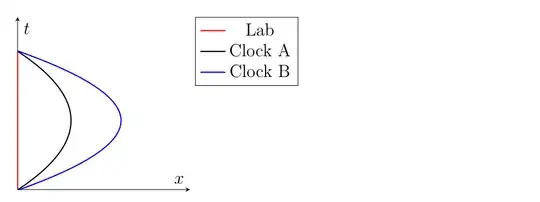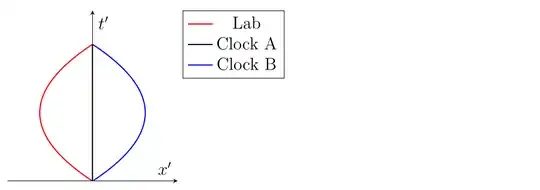This is the famous twin paradox, but with triplets. Let's introduce two clocks A and B and send them away in the $x$-direction, but with different velocities, while we stay behind in the lab. At some point, the clocks must decelerate to get them back to the lab. In our frame, the worldlines of the clocks will look something like this:

As you say, it's possible to compute the elapsed time of the travelling clocks, and compare it to the lab clock. To be specific, the time measured by the clocks will be proportional to the length of their trajectories with respect to the Minkowski metric
$$
\mathrm{d}s^2 = -c^2\mathrm{d}t^2 + \mathrm{d}x^2.
$$
The proper time is then given by $\mathrm{d}\tau^2 = -\mathrm{d}s^2/c^2$. Hence,
$$
\mathrm{d}\tau = \sqrt{1-\frac{1}{c^2}\frac{\mathrm{d}x^2}{\mathrm{d}t^2}}\mathrm{d}t = \sqrt{1-\frac{v^2}{c^2}}\mathrm{d}t.
$$
Let's assume that both clocks depart at time $t_i$ and return at $t_f$ and that $|v_B|\geq |v_A|$ throughout. By dividing the elapsed times of clocks A and B, we obtain their "averaged relative rate":
$$
\frac{\Delta\tau_A}{\Delta\tau_B} = \frac{\int_{t_i}^{t_f}\sqrt{1-\frac{v_A^2}{c^2}}\mathrm{d}t}{\int_{t_i}^{t_f}\sqrt{1-\frac{v_B^2}{c^2}}\mathrm{d}t} \geq 1.
$$
At any one moment, we also have the relative rate
$$
\frac{\mathrm{d}\tau_A}{\mathrm{d}\tau_B} = \frac{\sqrt{1-\frac{v_A^2}{c^2}}}{\sqrt{1-\frac{v_B^2}{c^2}}} \geq 1.
$$
We thus see that the clock that travels at the lower velocity (A) runs faster, as expected. Of course, the lab clock runs even faster. You may actually be wondering about what happens when you move along with one of the travelling clocks. In that case, the answer should be the same, because we can simply compare our clocks at time $t_f$. However, your spacetime diagram looks like

Based on this diagram, you might expect that the lab clock now runs slower than clock A. However, this is false, because lengths are measured differently in an accelerated reference frame. For the constant acceleration case depicted, you should use the Rindler metric. For the details of this computation, you should have a look at this answer.

